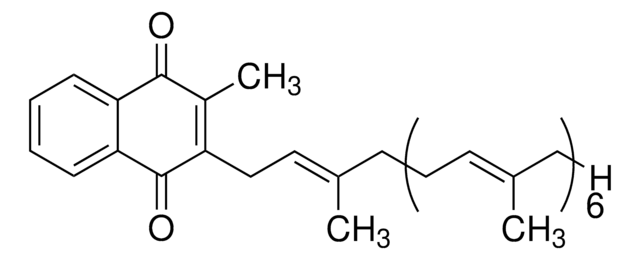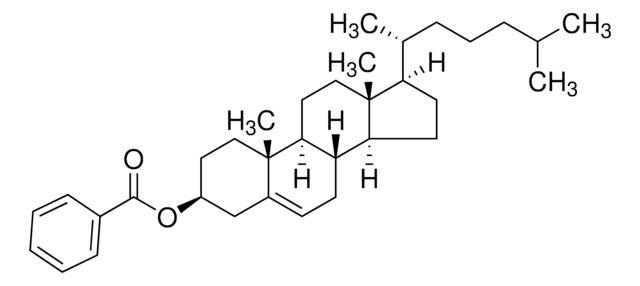1538006
USP
Phytonadione
United States Pharmacopeia (USP) Reference Standard
Synonym(s):
81818-54-4
Sign Into View Organizational & Contract Pricing
All Photos(1)
About This Item
Recommended Products
grade
pharmaceutical primary standard
API family
phytonadione
manufacturer/tradename
USP
application(s)
pharmaceutical (small molecule)
format
neat
storage temp.
2-8°C
General description
This product is provided as delivered and specified by the issuing Pharmacopoeia. All information provided in support of this product, including SDS and any product information leaflets have been developed and issued under the Authority of the issuing Pharmacopoeia.For further information and support please go to the website of the issuing Pharmacopoeia.
Application
Phytonadione USP reference standard, intended for use in specified quality tests and assays as specified in the USP compendia. Also, for use with USP monographs such as:
- Phytonadione Tablets
- Phytonadione Injectable Emulsion
- Oil-Soluble Vitamins Preparation
- Oil-Soluble Vitamins Tablets
- Menaquinone-4
- Oil-Soluble Vitamins Oral Solution
Phytonadione USP reference standard, intended for use in specified quality tests and assays as specified in the USP compendia. Also, for use with USP monographs such as:
- Phytonadione Tablets
- Phytonadione Injectable Emulsion
- Phytonadione Compounded Oral Suspension
- Oil-Soluble Vitamins Preparation
- Oil-Soluble Vitamins Tablets
- Menaquinone-4
Analysis Note
These products are for test and assay use only. They are not meant for administration to humans or animals and cannot be used to diagnose, treat, or cure diseases of any kind.
Other Notes
Sales restrictions may apply.
related product
Product No.
Description
Pricing
Hazard Statements
Precautionary Statements
Hazard Classifications
Aquatic Chronic 4
Storage Class Code
10 - Combustible liquids
WGK
WGK 1
Flash Point(F)
Not applicable
Flash Point(C)
Not applicable
Choose from one of the most recent versions:
Certificates of Analysis (COA)
Lot/Batch Number
Sorry, we don't have COAs for this product available online at this time.
If you need assistance, please contact Customer Support.
Already Own This Product?
Find documentation for the products that you have recently purchased in the Document Library.
Customers Also Viewed
Carmela T M Mascio et al.
Antimicrobial agents and chemotherapy, 58(7), 3976-3982 (2014-05-07)
Surotomycin (CB-183,315) is an orally administered, minimally absorbed, selective bactericidal cyclic lipopeptide in phase 3 development for the treatment of Clostridium difficile-associated diarrhea. The aim of this study was to evaluate the emergence of resistance in C. difficile (ATCC 700057
C Rodriguez et al.
Food microbiology, 42, 166-171 (2014-06-16)
Clostridium difficile has been isolated from food animals and meat, specially ground pork and ground beef. The recovered isolates were closely related to C. difficile human strains, indicating that animals and food are possible transmission routes of human C. difficile infection. The
Ji-Hoi Moon et al.
BMC microbiology, 14, 218-218 (2014-08-26)
Polyphosphate (polyP) has bactericidal activity against a gram-negative periodontopathogen Porphyromonas gingivalis, a black-pigmented gram-negative anaerobic rod. However, current knowledge about the mode of action of polyP against P. gingivalis is incomplete. To elucidate the mechanisms of antibacterial action of polyP
C Rodriguez et al.
Veterinary microbiology, 172(1-2), 309-317 (2014-06-05)
Clostridium difficile has been identified as a significant agent of diarrhoea and enterocolitis in both foals and adult horses. Hospitalization, antibiotic therapy or changes in diet may contribute to the development of C. difficile infection. Horses admitted to a care
Hrisi Bahar Tokman et al.
Clinical laboratory, 60(11), 1879-1886 (2015-02-05)
Anaerobic bacteria play an important role in eye infections; however, there is limited epidemiologic data based on the the role of these bacteria in the etiology of keratitis and endophthalmitis. The aim of this re- search is to determine the
Our team of scientists has experience in all areas of research including Life Science, Material Science, Chemical Synthesis, Chromatography, Analytical and many others.
Contact Technical Service








